Sustainability of the Reanalysis Databases in Predicting the Wind and Wave Power along the European Coasts
Abstract
:1. Introduction
- Highlighting the joint evaluation of the European wind and wave energy potential, by considering multiple datasets which cover the time interval from 1900 to 2017 (118 years of data in total);
- Identify the strong points and weak points of these datasets, in order to analyze their usefulness for meteorological or renewable energy studies;
- Highlight the spatial and seasonal agreement (if any), by considering various reference sites defined at about 50 km distance from the shoreline.
2. Materials and Methods
2.1. The Target Areas
2.2. Data
3. Analysis of the Wind and Wave Conditions
4. Discussion of the Results
5. Conclusions
Acknowledgments
Author Contributions
Conflicts of Interest
Nomenclature
| AVISO | Archiving, Validation and Interpretation of Satellite Oceanographic |
| CFSR | Climate Forecast System Reanalysis |
| DMSP | Defense Meteorological Satellite Program |
| ECMWF | European Center for Medium-Range Weather Forecasts |
| ERA-CLIM | European Reanalysis of Global Climate Observations |
| Hs | Significant wave height |
| IFS | Integrated Forecast System |
| NaN | Not a Number |
| NCEP | National Centers for Environmental Prediction |
| Te | mean wave period |
| U10 | Wind speed at 10 m |
| UK | United Kingdom |
| UTC | Coordinated Universal Time |
References
- Lendle, A.; Schaus, M. Sustainability Criteria in the EU Renewable Energy Directive: Consistent with WTo Rules? ICTSD Information Note No. 2; International Centre for Trade and Sustainable Development: San Francisco, CA, USA, 2010; ISSN 1994-6856. [Google Scholar]
- Fabra, N.; Matthes, F.C.; Newbery, D.; Colombier, M. The Energy Transition in Europe: Initial Lessons from Germany, the UK and France; Towards a Low Carbon European Power Sector; CERRE (Centre on Regulation in Europe): Brussels, Belgium, 2015. [Google Scholar]
- Deloitte, C. Energy Market Reform in Europe. European Energy and Climate Policies: Achievements and Challenges to 2020 and Beyond; Deloitte Conseil: Paris, France, 2015. [Google Scholar]
- EEA (European Environment Agency). Renewable Energy in Europe 2017. Recent Growth and Knock-on Effects; EEA Report No. 3/2017; EEA: Copenhagen, Denmark, 2017; ISBN 978-92-9213-848-6. [Google Scholar]
- Eurosion. Living with Coastal Erosion in Europe: Sediment and Space for Sustainability. Part IV—A guide to Coastal Erosion Management Practices in Europe: Lessons Learned; Service Contract B4—3301/2001/329175/MAR/B3; EUCC: Leiden, The Netherlands, 2004. [Google Scholar]
- Randazzo, G.; Raventos, J.S.; Stefania, L. Coastal Erosion and Protection Policies in Europe: From EU Programme (Eurosion and Interreg Projects) to Local Management. In Coastal Hazards. Coastal Research Library; Finkl, C., Ed.; Springer: Dordrecht, The Netherlands, 2013; Volume 1000. [Google Scholar]
- Onea, F.; Rusu, E. The expected efficiency and coastal impact of a hybrid energy farm operating in the Portuguese nearshore. Energy 2016, 97, 411–423. [Google Scholar] [CrossRef]
- Rusu, E.; Onea, F. Study on the influence of the distance to shore for a wave energy farm operating in the central part of the Portuguese nearshore. Energy Convers. Manag. 2016, 114, 209–223. [Google Scholar] [CrossRef]
- Diaconu, S.; Rusu, E. The environmental impact of a Wave Dragon array operating in the Black Sea. Sci. World J. 2013, 498013. [Google Scholar] [CrossRef] [PubMed]
- Rusu, L.; Butunoiu, D.; Rusu, E. Analysis of the extreme storm events in the Black Sea considering the results of a ten-year wave hindcast. J. Environ. Prot. Ecol. 2014, 15, 445–454. [Google Scholar]
- Collet, I. Portrait of EU Coastal Regions; Eurostat 38/2010; Eurostat Agriculture and Fisheries: Luxembourg, 2010; ISSN 1977-0316. [Google Scholar]
- Souvorov, A.V. Marine Ecologonomics. The Ecology and Economics of Marine Natural Resources Management; Elsevier: Amsterdam, The Netherlands, 1999; ISSN 0-444-82659-9. [Google Scholar]
- Xu, G.; Shen, W.; Wang, X. Applications of wireless sensor networks in marine environment monitoring: A survey. Sensors 2014, 14, 16932–16954. [Google Scholar] [CrossRef] [PubMed]
- Krogstad, H.E.; Barstow, S.F. Satellite wave measurements for coastal engineering applications. Coast. Eng. 1999, 37, 283–307. [Google Scholar] [CrossRef]
- Janssen, P.; Bidlot, J.-R.; Abdalla, S.; Hersbach, H. Progress in Ocean Wave Forecasting at ECMWF; European Centre for Medium-Range Weather Forecasts Report; ECMWF: Reading, UK, 2005. [Google Scholar]
- Sempreviva, A.M.; Barthelmie, R.J.; Pryor, S.C. Review of methodologies for offshore wind resource assessment in European seas. Surv. Geophys. 2008, 29, 471–497. [Google Scholar] [CrossRef]
- Hasager, C.B.; Mouche, A.; Badger, M.; Bingol, F.; Karagali, I.; Driesenaar, T.; Stoffelen, A.; Pena, A.; Longepe, N. Offshore wind climatology based on synergetic use of Envisat ASAR, ASCAT and QuikSCAT. Remote Sens. Environ. 2015, 156, 247–263. [Google Scholar] [CrossRef] [Green Version]
- Emmanouil, G.; Galanis, G.; Kalogeri, C.; Zodiatis, G.; Kallos, G. 10-year high resolution study of wind, sea waves and wave energy assessment in the Greek offshore areas. Renew. Energy 2016, 90, 399–419. [Google Scholar] [CrossRef]
- Foti, E.; Musumeci, R.; Leanza, S.; Cavallaro, L. Feasibility of an offshore wind farm in the gulf of Gela: Marine and structural issues. Wind Eng. 2010, 34, 65–84. [Google Scholar] [CrossRef]
- Iuppa, C.; Cavallaro, L.; Foti, E.; Vicinanza, D. Potential wave energy production by different wave energy converters around Sicily. J. Renew. Sustain. Energy 2015, 7. [Google Scholar] [CrossRef]
- Liberti, L.; Carillo, A.; Sannino, G. Wave energy resource assessment in the Mediterranean, the Italian perspective. Renew. Energy 2013, 50, 938–949. [Google Scholar] [CrossRef]
- Omrani, H.; Drobinski, P.; Arsouze, T.; Bastin, S.; Lebeaupin-Brossier, C.; Mailler, S. Spatial and temporal variability of wind energy resource and production over the North Western Mediterranean Sea: Sensitivity to air-sea interactions. Renew. Energy 2017, 101, 680–689. [Google Scholar] [CrossRef]
- Soukissian, T.; Karathanasi, F.; Axaopoulos, P. Satellite-based offshore wind resource assessment in the Mediterranean Sea. IEEE J. Ocean. Eng. 2017, 42, 73–86. [Google Scholar] [CrossRef]
- Soukissian, T.H.; Papadopoulos, A. Effects of different wind data sources in offshore wind power assessment. Renew. Energy 2015, 77, 101–114. [Google Scholar] [CrossRef]
- Onea, F.; Rusu, E. Wind energy assessments along the Black Sea basin. Meteorol. Appl. 2014, 21, 316–329. [Google Scholar] [CrossRef]
- Onea, F.; Raileanu, A.; Rusu, E. Evaluation of the wind energy potential in the coastal environment of two enclosed seas. Adv. Meteorol. 2015, 2015, 808617. [Google Scholar] [CrossRef]
- Onea, F.; Deleanu, L.; Rusu, L.; Georgescu, C. Evaluation of the wind energy potential along the Mediterranean Sea coasts. Energy Explor. Exploit. 2016, 34, 766–792. [Google Scholar] [CrossRef]
- Liliana, R.; Onea, F. The performance of some state-of-the-art wave energy converters in locations with the worldwide highest wave power. Renew. Sustain. Energy Rev. 2017, 75, 1348–1362. [Google Scholar] [CrossRef]
- Zanopol, A.T.; Onea, F.; Rusu, E. Evaluation of the coastal influence of a generic wave farm operating in the Romanian nearshore. J. Environ. Prot. Ecol. 2014, 15, 597–605. [Google Scholar]
- Liliana, R.; Onea, F. Assessment of the performances of various wave energy converters along the European continental coasts. Energy 2015, 82, 889–904. [Google Scholar] [CrossRef]
- Rusu, E. Evaluation of the wave energy conversion efficiency in various coastal environments. Energies 2014, 7, 4002–4018. [Google Scholar] [CrossRef]
- Rusu, E.; Onea, F. Estimation of the wave energy conversion efficiency in the Atlantic Ocean close to the European islands. Renew. Energy 2016, 85, 687–703. [Google Scholar] [CrossRef]
- Fan, Y.; Lin, S.-J.; Held, I.M.; Yu, Z.; Tolman, H.L. Global ocean surface wave simulation using a coupled atmosphere-wave model. J. Clim. 2012, 25, 6233–6252. [Google Scholar] [CrossRef]
- Rusu, L.; Bernardino, M.; Soares, C.G. Wind and wave modelling in the Black Sea. J. Oper. Oceanogr. 2014, 7, 5–20. [Google Scholar] [CrossRef]
- Rusu, L. Assessment of the wave energy in the Black Sea based on a 15-year hindcast with data assimilation. Energies 2015, 8, 10370–10388. [Google Scholar] [CrossRef]
- Bernardino, M.; Guedes Soares, C. Evaluating marine climate change in the Portuguese coast during the 20th century. In Maritime Transportation and Harvesting of Sea Resources; Guedes Soares & Teixeira, Ed.; Taylor & Francis Group: London, UK, 2018; pp. 1089–1095. [Google Scholar]
- Kalogeri, C.; Galanis, G.; Spyrou, C.; Diamantis, D.; Baladima, F.; Koukoula, M.; Kallos, G. Assessing the European offshore wind and wave energy resource for combined exploitation. Renew. Energy 2017, 101, 244–264. [Google Scholar] [CrossRef]
- GuedesSoares, C.; Bento, A.R.; Gonçalves, M.; Silva, D.; Martinho, P. Numerical evaluation of the wave energy resource along the Atlantic European coast. Comput. Geosci. 2014, 71, 37–49. [Google Scholar] [CrossRef]
- Iglesias, G.; Carballo, R. Wave energy and nearshore hot spots: The case of the SE Bay of Biscay. Renew. Energy 2010, 35, 2490–2500. [Google Scholar] [CrossRef]
- Risien, C.M.; Chelton, D.B. A satellite-derived climatology of global ocean winds. Remote Sens. Environ. 2006, 105, 221–236. [Google Scholar] [CrossRef]
- European Centre for Medium-Range Weather Forecasts (ECMWF). ERA Report Series No.1 Version 2.0; European Centre for Medium-Range Weather Forecasts: Reading, UK, 2006. [Google Scholar]
- Persson, A.; Grazzini, F. User Guide to ECMWF Forecast Products 4.0; ECMWF Report; European Centre for Medium-Range Weather Forecasts (ECMWF): Reading, UK, 2007. [Google Scholar]
- Shanas, P.R.; Sanil Kumar, V. Temporal variations in the wind and wave climate at a location in the eastern Arabian Sea based on ERA-interim reanalysis data. Nat. Hazards Earth Syst. Sci. 2014, 14, 1371–1381. [Google Scholar] [CrossRef] [Green Version]
- Kubik, M.L.; Coker, P.J.; Hunt, C. Using meteorological wind data to estimate turbine generation output: A sensitivity analysis. In Proceedings of the World Renewable Energy Congress 2011, Linkoping, Sweden, 8–13 May 2011; pp. 4074–4081. [Google Scholar]
- Poli, P.; Hersbach, H.; Berrisford, P.; Dee, D.; Simmons, A.; Laloyaux, P. ERA-20C Deterministic, Report 20, 48 pp; European Centre for Medium-Range Weather Forecasts (ECMWF): Reading, UK, 2015. [Google Scholar]
- Rusu, E.; Onea, F. Joint evaluation of the wave and offshore wind energy resources in the developing countries. Energies 2017, 10, 1866. [Google Scholar] [CrossRef]
- Saha, S.; Moorthi, S.; Pan, H.L.; Wu, X.; Wang, J.; Nadiga, S.; Tripp, P.; Kistler, R.; Woollen, J.; Behringer, D.; et al. The NCEP climate forecast system reanalysis. Bull. Am. Meteorol. Soc. 2010, 91, 1015–1057. [Google Scholar] [CrossRef]
- Saha, S.; Moorthi, S.; Wu, X.; Wang, J.; Nadiga, S.; Tripp, P.; Behringer, D.; Hou, Y.-T.; Chuang, H.-Y.; Iredell, M.; et al. The NCEP Climate Forecast System Version 2. J. Clim. 2014, 27, 2185–2208. [Google Scholar] [CrossRef]
- AVISO. Available online: http://www.aviso.altimetry.fr/en/data.html (accessed on September 2017).
- Western European Union. Wind and Waves Atlas of the Mediterranean Sea; Western European Armaments Organization Research Cell: Paris, France, 2004; 386p. [Google Scholar]
- Dong, Y.; Peng, C.Y.J. Principled missing data methods for researchers. SpringerPlus 2013, 2, 222. [Google Scholar] [CrossRef] [PubMed]
- Makarynskyy, O.; Makarynska, D.; Rusu, E.; Gavrilov, A. Filling gaps in wave records with artificial neural networks. Marit. Transp. Exploit. Ocean Coast. Resour. 2005, 2, 1085–1091. [Google Scholar]
- Rusu, L.; Ganea, D.; Mereuta, E. A joint evaluation of wave and wind energy resources in the Black Sea based on 20-year hindcast information. Energy Explor. Exploitat. 2017, 1–17. [Google Scholar] [CrossRef]
- NOAA WAVEWATCH III® CFSR Reanalysis Hindcasts. 2018. Available online: http://polar.ncep.noaa.gov/waves/CFSR_hindcast.shtml (accessed on 6 January 2018).
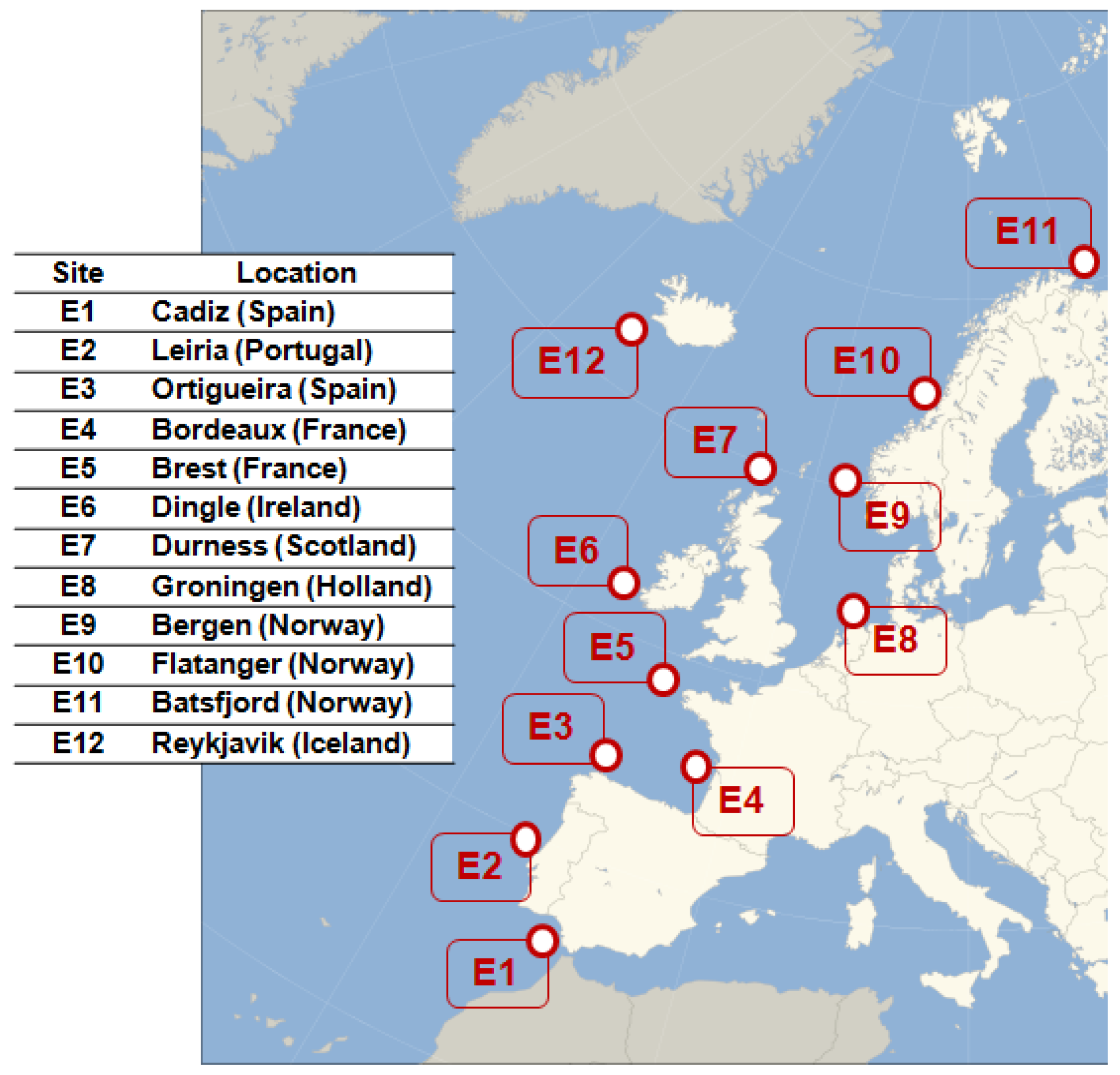
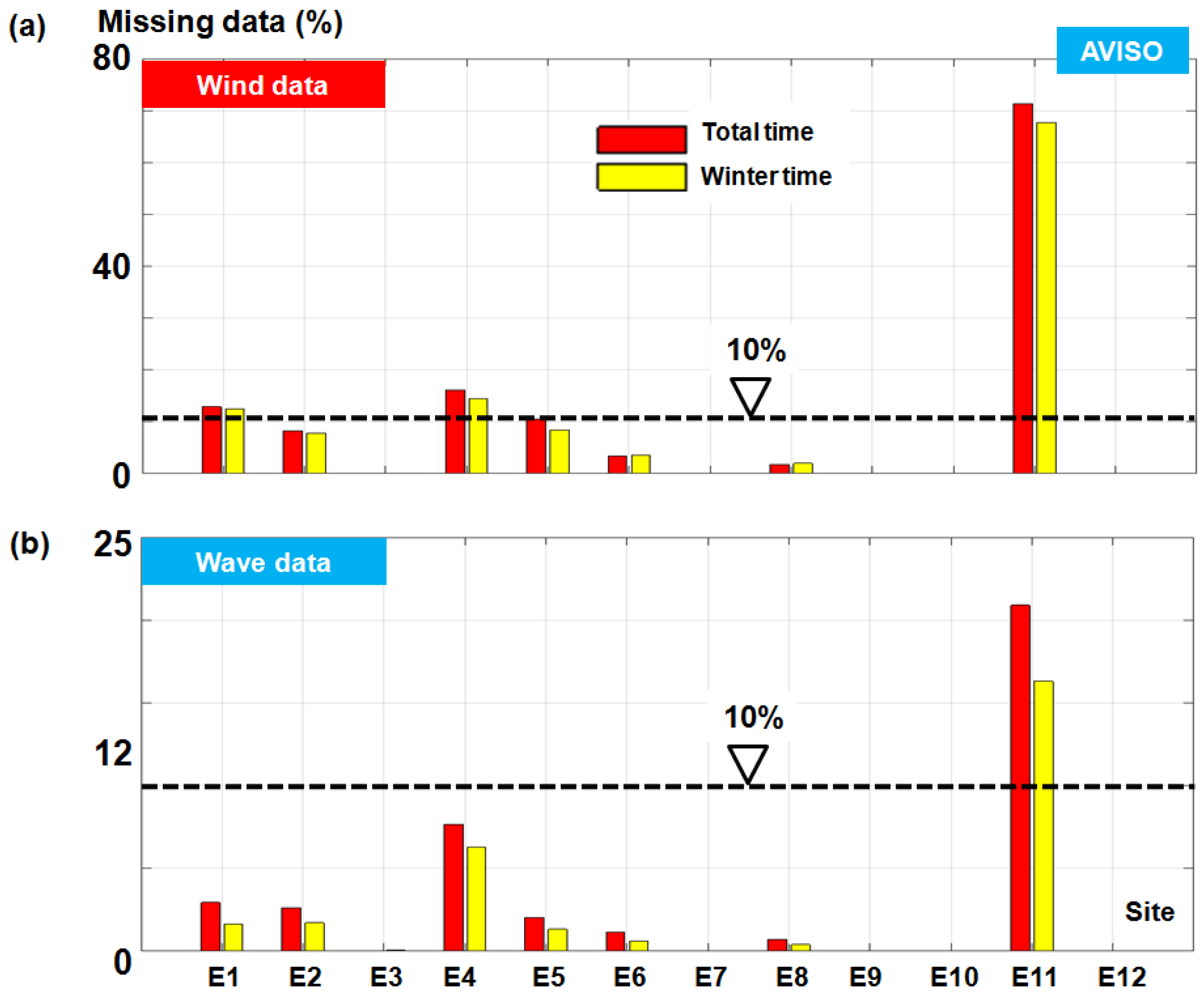

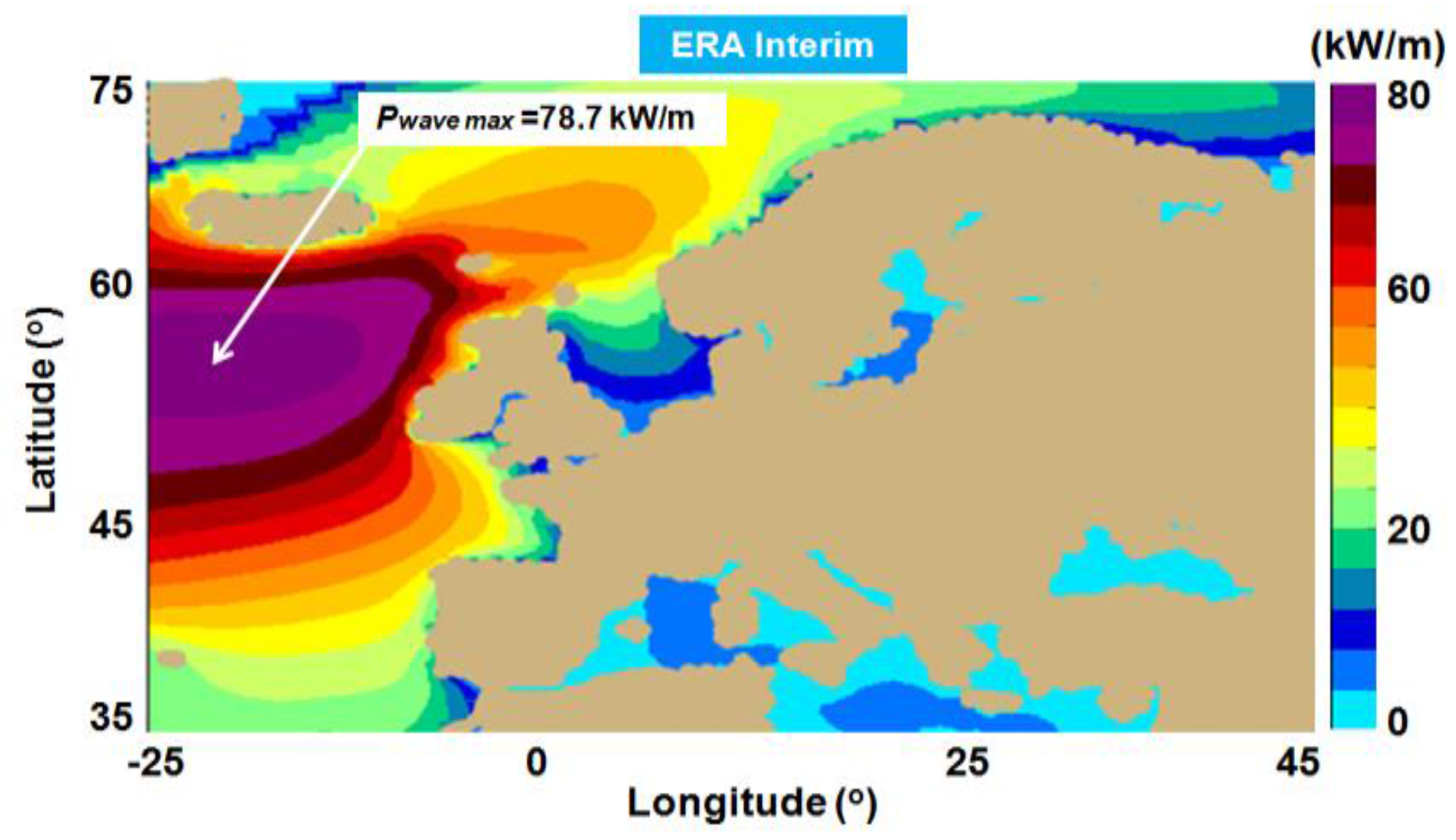
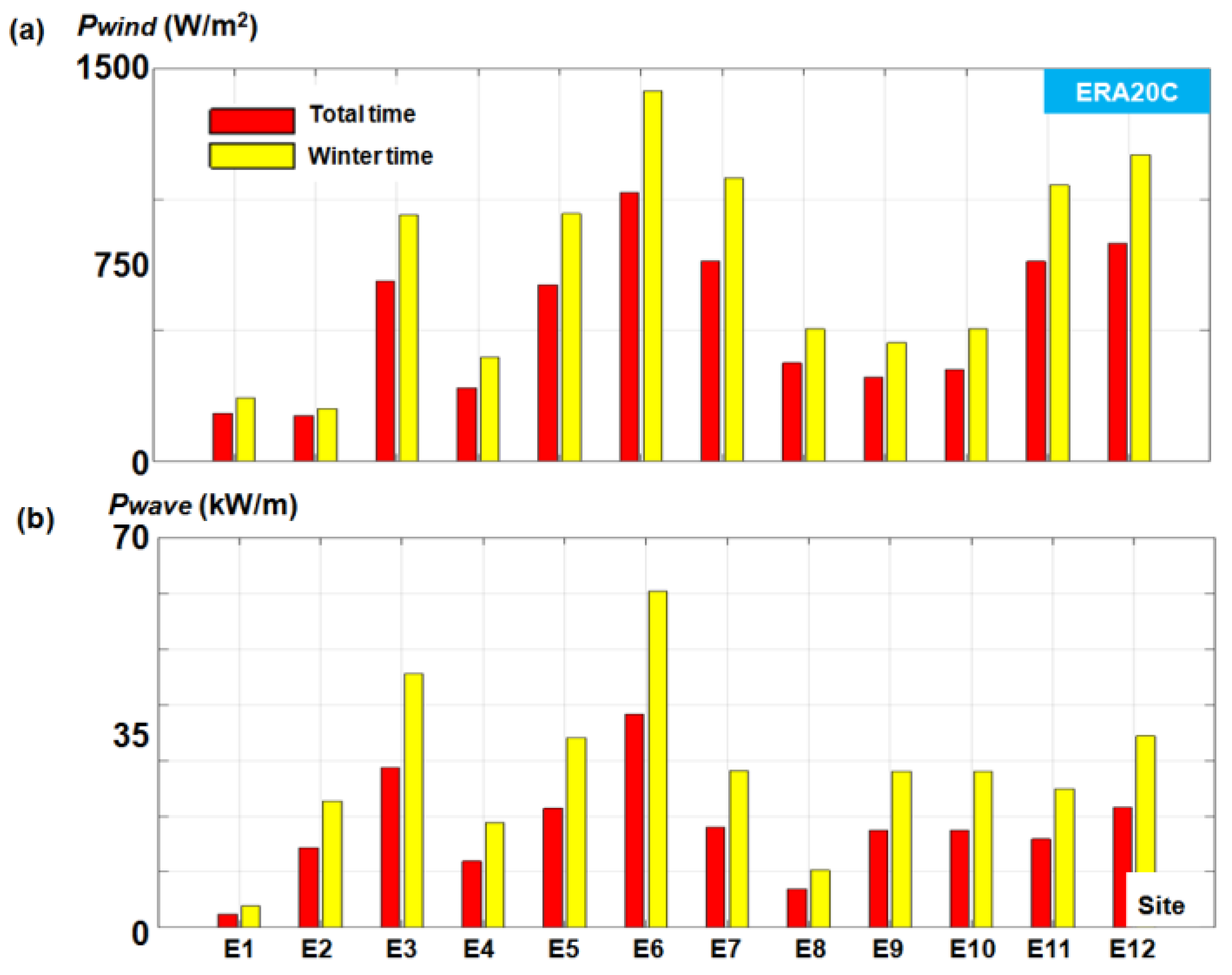
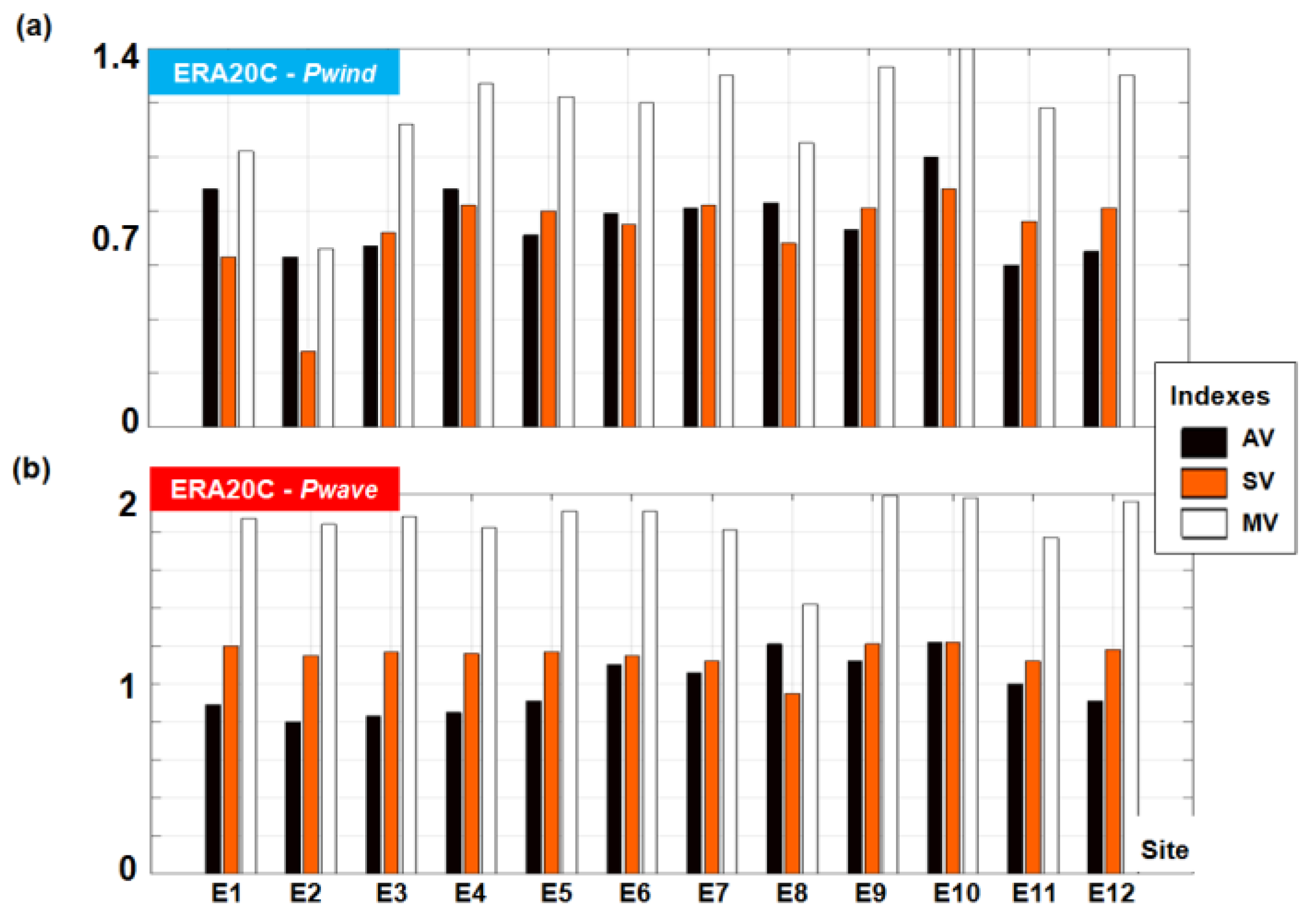
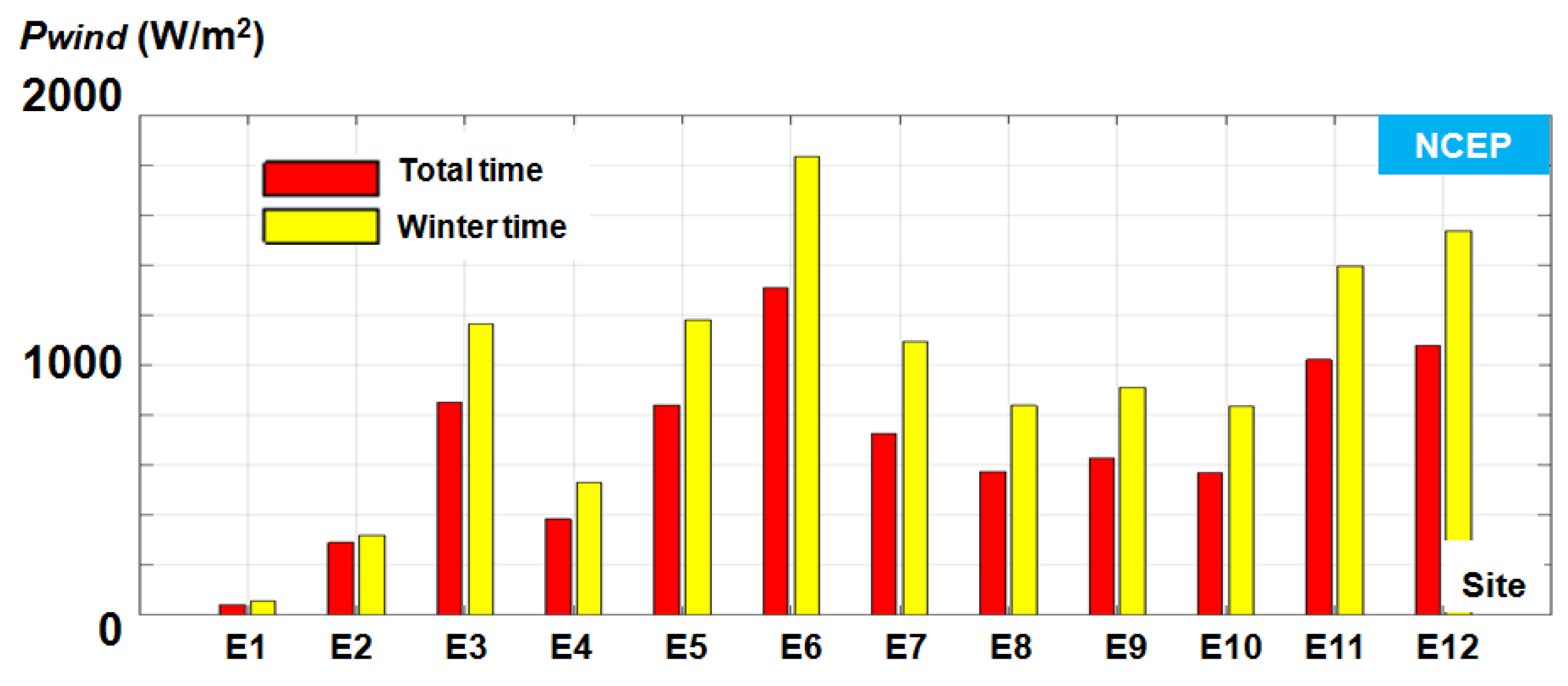
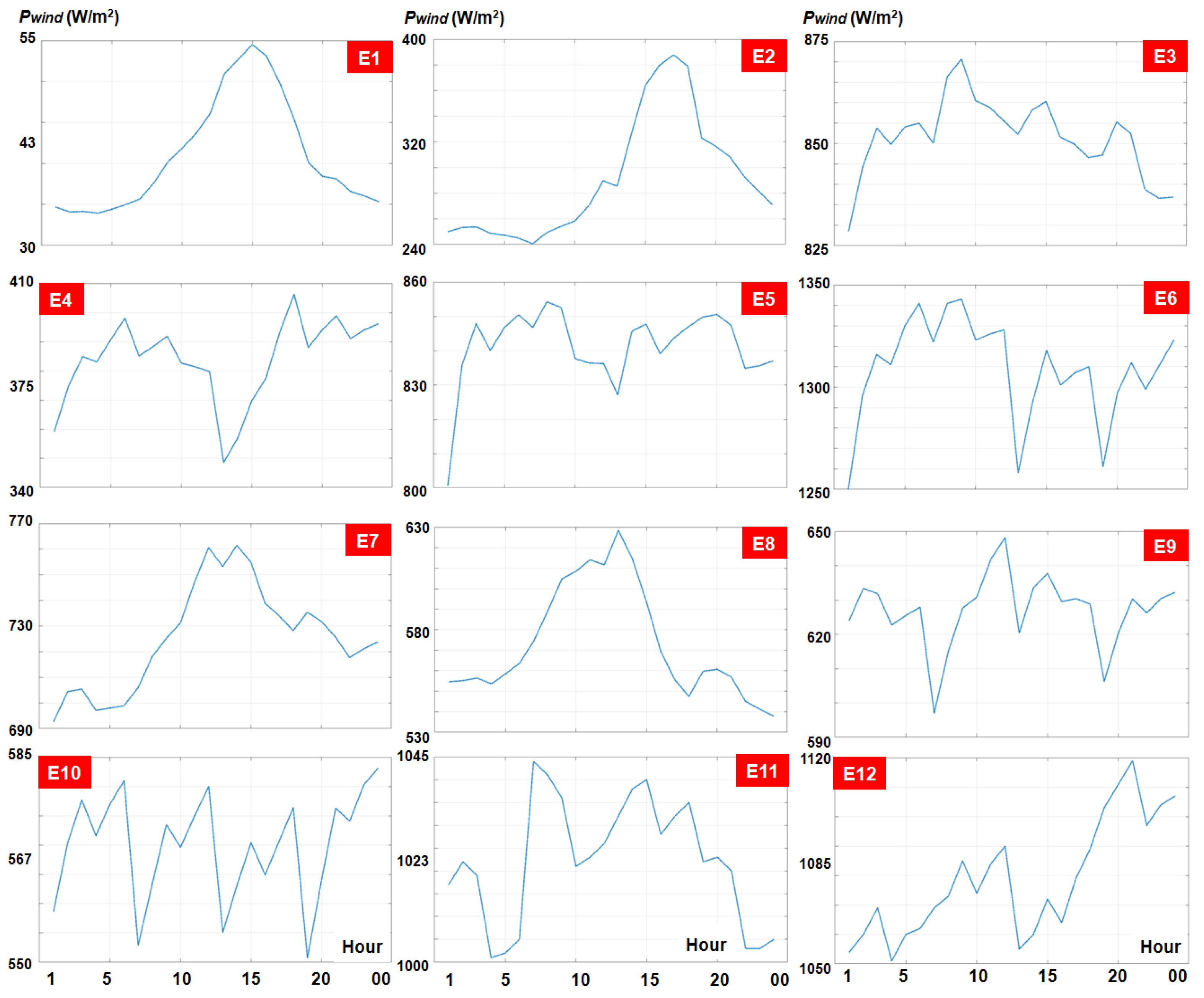


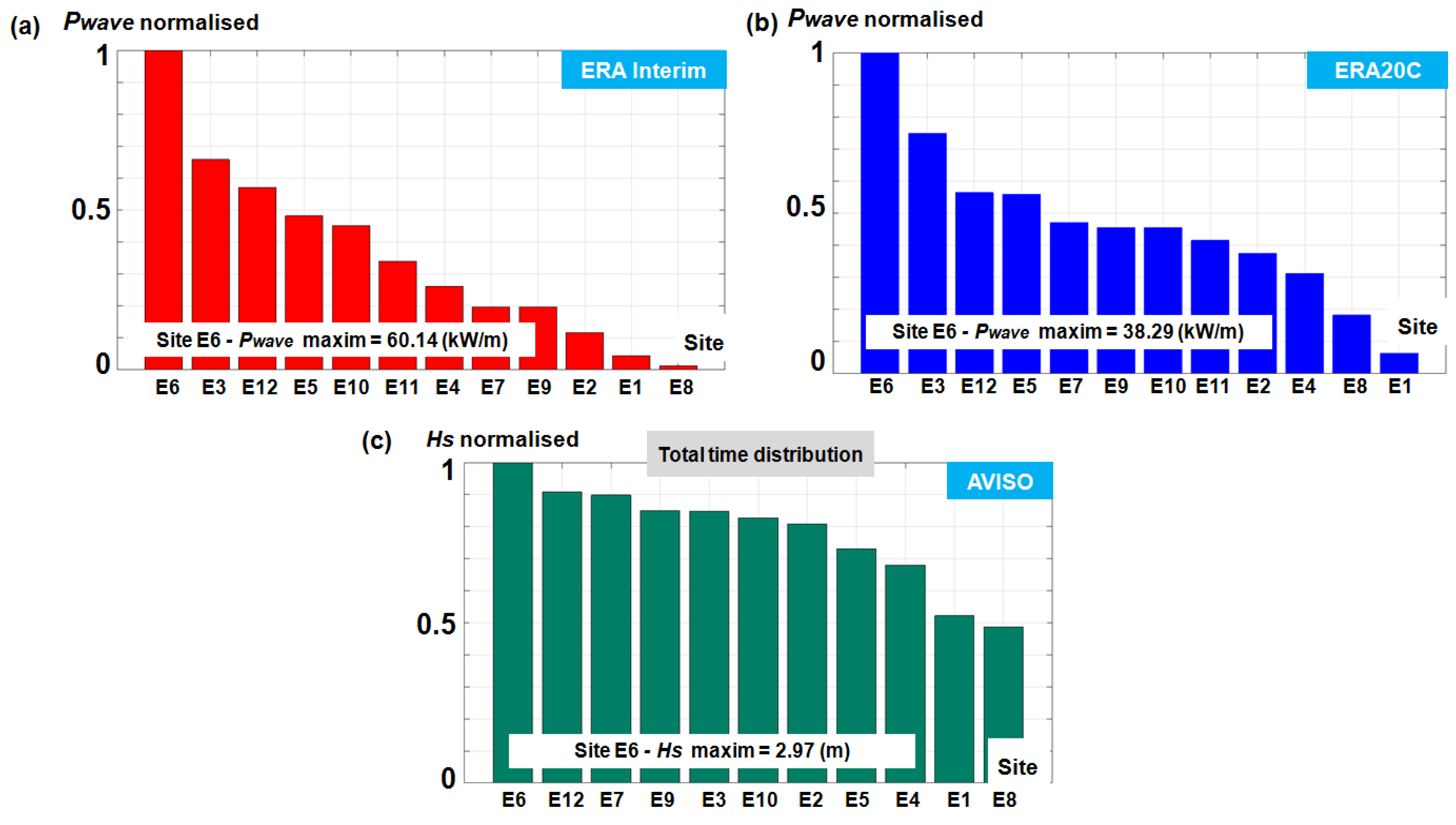
| Database → | ERA Interim | ERA20C | NCEP | AVISO |
|---|---|---|---|---|
| Characteristic↓ | ||||
| Parameter | wind/waves | wind/waves | wind | wind/waves |
| Start date | 1979-01-01 | 1900-01-01 | 1979-01-01 | 2009-09-14 |
| End date | 2017-07-31 | 2010-12-31 | 2010-12-31 | 2017-11-26 |
| Time step | 6 h (4 per day) | 6 h (4 per day) | 1 h (24 per day) | 1 per day |
| Spatial resolution (°) | 0.75°× 0.75° | 0.75°× 0.75° | 0.312°× 0.312° | 1°× 1° |
| Sites→ | E1 | E2 | E3 | E4 | E5 | E6 | E7 | E8 | E9 | E10 | E11 | E12 | |
|---|---|---|---|---|---|---|---|---|---|---|---|---|---|
| Database↓ | |||||||||||||
| ERAInterim(1979–2017) | Mean | 196 | 270 | 810 | 277 | 754 | 1177 | 1066 | 453 | 435 | 560 | 817 | 945 |
| 95th | 775 | 943 | 2992 | 1156 | 2802 | 4184 | 3860 | 1704 | 1803 | 2327 | 2930 | 3542 | |
| 99th | 1570 | 1694 | 5286 | 2534 | 5082 | 7180 | 6676 | 3028 | 3394 | 4643 | 4928 | 6357 | |
| ERA20C(1900–2010) | Mean | 183 | 176 | 689 | 281 | 674 | 1026 | 766 | 376 | 321 | 350 | 763 | 831 |
| 95th | 703 | 637 | 2619 | 1171 | 2579 | 3660 | 2802 | 1395 | 1259 | 1456 | 2797 | 3096 | |
| 99th | 1556 | 1219 | 4718 | 2506 | 4592 | 6212 | 4735 | 2444 | 2262 | 2892 | 4853 | 5443 | |
| NCEP(1979–2010) | Mean | 41 | 290 | 851 | 384 | 841 | 1308 | 725 | 573 | 627 | 570 | 1022 | 1078 |
| 95th | 164 | 1080 | 3158 | 1520 | 3152 | 4729 | 2875 | 2186 | 2632 | 2362 | 3689 | 4180 | |
| 99th | 373 | 1956 | 5863 | 3136 | 5803 | 8604 | 5440 | 3934 | 5235 | 4784 | 6519 | 8302 | |
| AVISO(2009–2017) | Mean | 176 | 300 | 382 | 256 | 376 | 667 | 661 | 433 | 578 | 507 | x | 627 |
| 95th | 696 | 1256 | 1525 | 1148 | 1624 | 2663 | 2636 | 1620 | 2349 | 2194 | x | 2423 | |
| 99th | 1438 | 2445 | 3103 | 2379 | 2990 | 4851 | 4507 | 3485 | 4051 | 3764 | x | 3923 | |
| Sites→ | E1 | E2 | E3 | E4 | E5 | E6 | E7 | E8 | E9 | E10 | E11 | E12 | |
|---|---|---|---|---|---|---|---|---|---|---|---|---|---|
| Database↓ | |||||||||||||
| ERAInterim(Hs→m) | Mean | 0.82 | 1.31 | 2.53 | 1.54 | 2.17 | 3.05 | 1.56 | 0.62 | 1.65 | 2.10 | 2.01 | 2.36 |
| 95th | 1.58 | 2.50 | 5.04 | 3.31 | 4.52 | 6.17 | 3.23 | 1.38 | 3.42 | 4.47 | 4.11 | 4.89 | |
| 99th | 2.21 | 2.26 | 6.75 | 4.54 | 6.14 | 8.26 | 4.32 | 1.87 | 4.45 | 6.05 | 5.51 | 6.60 | |
| ERA20C(Hs→m) | Mean | 0.78 | 1.54 | 2.21 | 1.41 | 1.93 | 2.54 | 1.83 | 1.24 | 1.72 | 1.72 | 1.77 | 1.96 |
| 95th | 1.63 | 3.13 | 4.57 | 3.17 | 4.17 | 5.27 | 3.78 | 2.93 | 3.78 | 3.90 | 3.88 | 4.24 | |
| 99th | 2.32 | 4.23 | 6.17 | 4.48 | 5.71 | 7.04 | 5.05 | 4.09 | 5.18 | 5.51 | 5.45 | 5.81 | |
| AVISO(Hs→m) | Mean | 1.55 | 2.40 | 2.52 | 2.02 | 2.17 | 2.97 | 2.67 | 1.44 | 2.52 | 2.46 | x | 2.69 |
| 95th | 2.79 | 4.43 | 4.90 | 4.17 | 4.43 | 5.66 | 5.01 | 2.82 | 4.87 | 4.98 | x | 5.01 | |
| 99th | 3.60 | 5.62 | 6.71 | 6.00 | 5.83 | 7.33 | 6.12 | 3.68 | 6.06 | 6.24 | x | 5.86 | |
© 2018 by the authors. Licensee MDPI, Basel, Switzerland. This article is an open access article distributed under the terms and conditions of the Creative Commons Attribution (CC BY) license (http://creativecommons.org/licenses/by/4.0/).
Share and Cite
Onea, F.; Rusu, E. Sustainability of the Reanalysis Databases in Predicting the Wind and Wave Power along the European Coasts. Sustainability 2018, 10, 193. https://doi.org/10.3390/su10010193
Onea F, Rusu E. Sustainability of the Reanalysis Databases in Predicting the Wind and Wave Power along the European Coasts. Sustainability. 2018; 10(1):193. https://doi.org/10.3390/su10010193
Chicago/Turabian StyleOnea, Florin, and Eugen Rusu. 2018. "Sustainability of the Reanalysis Databases in Predicting the Wind and Wave Power along the European Coasts" Sustainability 10, no. 1: 193. https://doi.org/10.3390/su10010193






